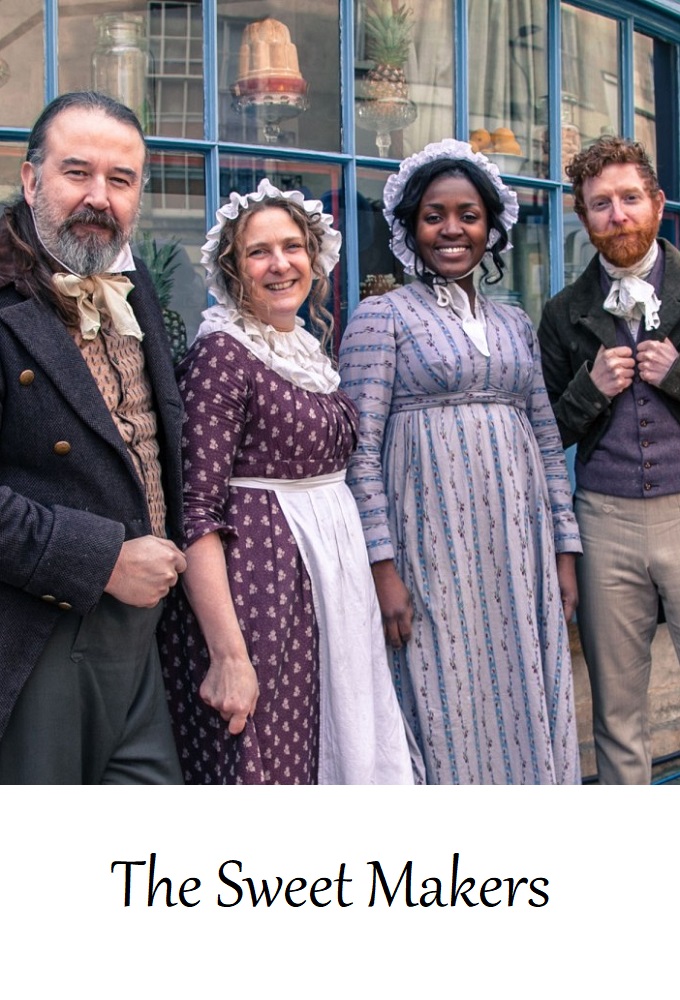
The Sweet Makers
5/5
Année : 2017
Nombre de saisons : 1
Durée moyenne d'un épisode : 60 minutes
Genre(s) : Documentaire, Cuisine, Histoire, Mini-série, Télé-réalité
Four modern confectioners recreate the treats of the past, from a Tudor sugar banquet to giant Easter eggs, and discover the roots of our national sweet tooth.
Saisons

Saison 1
Épisodes
Choisissez votre saison au dessus et découvrez les épisodes qui vous attendent !
Épisode 1 - A Tudor Treat
19 juillet 2017
Four modern-day confectioners step back in time to discover what life was like for their Tudor predecessors. They explore how our national sweet tooth developed as the tables of the aristocracy now boasted fantastic displays of sugarcraft to show off their wealth and status. The sweetmakers also explore the negative side of the introduction of sugar to the Tudor lifestyle, including the impact on teeth and fuelling our involvement in the most shameful chapters in British history - the slave trade. Guided by food historian Dr Annie Gray and social historian Emma Dabiri, our modern professionals are entering the world of the 16th-century confectioner - a time when sugar was believed to have medicinal qualities and was so valuable it was kept under lock and key. Sugar was the preserve of the elite so every dish the team makes forms part of an elaborate aristocratic sugar banquet. Our confectioners are chocolatier Paul A Young, wedding cake designer Cynthia Stroud, sweet consultant Andy Baxendale and chocolatier Diana Short. They spend four days using original recipes, ingredients and equipment to create dishes that haven't been made, let alone tasted, for hundreds of years. Their final lavish sugar banquet includes candied roses (believed to cure gonorrhea), a sweet candied root that was considered to be a Tudor aphrodisiac, sugar plates and goblets, gorgeously decorated marzipan and a spectacular model banqueting house made entirely of sugar.
Épisode 2 - A Georgian Treat
26 juillet 2017
Four modern-day confectioners use original recipes to recreate a Georgian shop and a stunning dessert course and discover how the quest to satisfy our national sweet tooth transformed Britain. Guided by food historian Dr Annie Gray and social historian Emma Dabiri, our 21st-century sweetmakers are in Bath to experience first-hand the life of confectioners in late 18th- and early 19th-century England - a time when the wealth from the sugar plantations of the Caribbean had made Britain rich and Bath's residents were making a fortune from the slave trade. They are now catering to the wealthy middle classes who could spend up to the modern equivalent of £2,000 on a bespoke dessert course to dazzle their guests. Every dish the team make across four days in the kitchen forms part of the stock for their shop and this spectacular final course at one of the most famous addresses in Bath, the Royal Crescent. Our confectioners use period equipment such as Georgian ice chests, sorbetieres and beautiful pewter moulds, original recipes and authentic ingredients and create dishes that haven't been made, let alone tasted, for hundreds of years. The four confectioners are Paul A Young, who runs two boutique chocolate shops in London, Cynthia Stroud, a bespoke wedding cake decorator, Diana Short, who owns her own chocolate company, and sweet consultant Andy Baxendale, whose first job in the industry was in the Chewitts factory. They each bring a unique set of skills and experience to the job - but they quickly come to appreciate the immense skill of their confectionery predecessors. They discover how the art of the confectioner peaked in the Georgian era as wealthy customers and abundant sugar supplies from the plantations allowed them to experiment with all of the latest fashions from Italy and France. Andy blows sugar as chemistry catches up with confectionery, and they learn the Georgian trick of adding salt to their ice to freeze ice cream. Celebrity confectioners such a
Épisode 3 - A Victorian Treat
2 août 2017
Four modern confectioners use original recipes to recreate a Victorian sweet shop and discover how the quest to satisfy our national sweet tooth transformed Britain. Guided by food historian Dr Annie Gray and social historian Emma Dabiri our 21st century sweet makers are in Blists Hill, Shropshire to experience first-hand the life of confectioners in late 19th and early 20th century England - a time when cheap sugar meant sweets for every class in society for the first time. Children finally get their hands on chocolate, and the modern brands that we still know and love today are dreamt up.
Épisode 4 - ... At Christmas
15 décembre 2017 - 5/5
Four modern confectioners immerse themselves in the world of their professional predecessors, discovering how commercially canny sweet makers helped shape the way Christmas is celebrated. Guided by food historian Dr Annie Gray and social historian Emma Dabiri, the confectioners work their way through three distinct periods of history. As the 21st-century confectioners wrestle with period equipment and ingredients to make a series of sweet delights from the Georgian, Victorian and Interwar eras, they discover how sweet makers in the past spotted the commercial potential of Christmas and developed innovative festive products for an eagerly receptive audience. As a result, many of the things that signify Christmas are the creation of confectioners. The Georgian era introduced the idea of consumerism at Christmas. In this period, Christmas was a thoroughly adult affair - alcohol, partying and over indulgence marked out festivities, with the social and economic elite throwing opulent and sophisticated parties in their homes and children being kept very much out of the picture. The focus of the celebrations was 12th Night rather than Christmas day itself. The Victorian period sees the focus of Christmas consumerism shift. Gone are the hedonistic revelries of the Georgian period, Christmas is now a holiday much more centred around children. The confectioners' new task is to satisfy the demands of this emerging market with everything from sugar mice to cheap jelly sweets, candy canes and bags of sugary bonbons. Christmas in the 1920s was focused more on shopping than ever before. The confectioners need to fill their shop with even more magical treats to tempt in customers. In an increasingly competitive market, confectioners compete to create new products branded with the Christmas market in mind.
Vidéos
Oups aucune vidéo pour le moment... Revenez plus tard pour des aventures en images !

Aucun avis pour le momment...